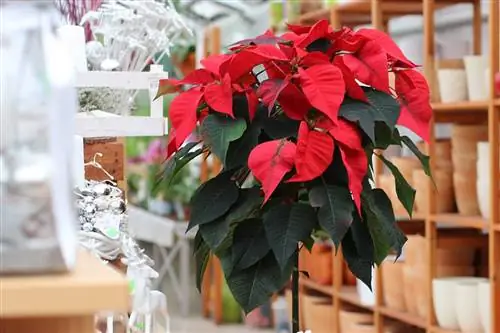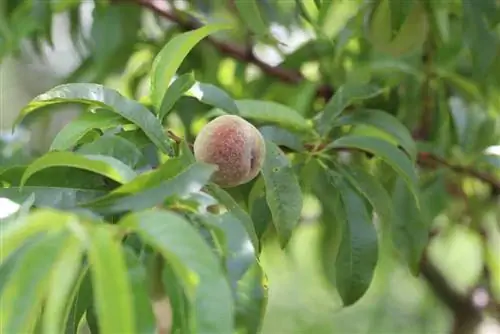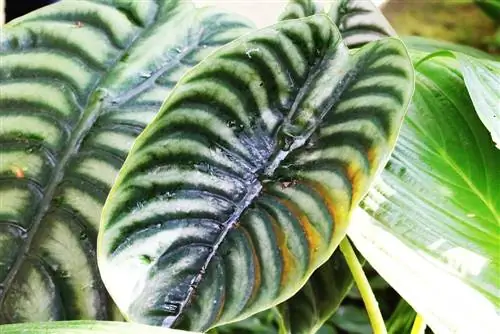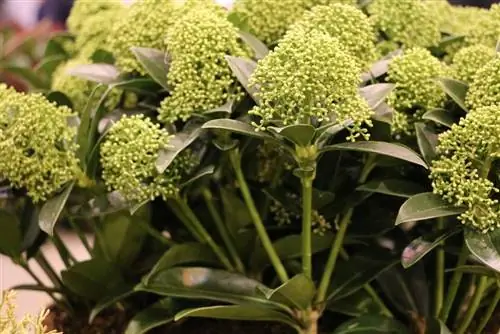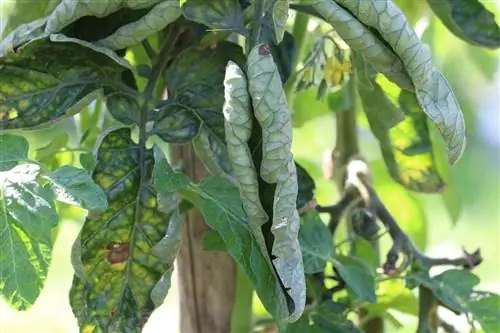- Author admin [email protected].
- Public 2023-12-17 03:39.
- Last modified 2025-01-24 12:45.
It decorates many living rooms in winter and, as a tropical plant, has certain requirements. If these are not met, it shows this, among other things. on rolled leaves. But what are the causes?
Cold as a cause
In its full splendor, the poinsettia (Euphorbia pulcherrima) is a real eye-catcher. But the joy disappears relatively quickly when the plant weakens. This is a sign that she has a problem. If the leaves curl up, hang limply and fall off, cold and drafts may be the cause. Heat can also take its toll on this plant. However, it is particularly sensitive to low temperatures. If it stands in a place that is too cold for a long time, it can react with a cold shock. Drafts from both cold and warm air are also not good for this extraordinary plant.
Remedy
- Place Euphorbia pulcherrima in a bright and warm place
- Plants damaged by drafts in a protected place
- additional protection against cold floors
- to do this, place it on a cork base or similar insulation
- optimal temperatures between 18 and 20 degrees
- not significantly warmer, not colder than 16 degrees
- Avoid strong temperature fluctuations
- otherwise risk of leaf damage
Caution is advised when buying a poinsettia and transporting it into your living room at home, because sales rooms usually do not meet the requirements of these plants. You can protect them from cold damage during transport by using warm packaging. It can also be easily transported in a standard cool box.
Leaf damage due to drought
If the leaves of the poinsettia curl up, turn yellow and wilt, incorrect watering can also be the cause. The plants can be affected by a lack of water or prolonged drought as well as by too much moisture. If the soil dries out, the heating air is too dry or the sun is too intense. In some cases the soil can also dry out due to insufficient humidity.
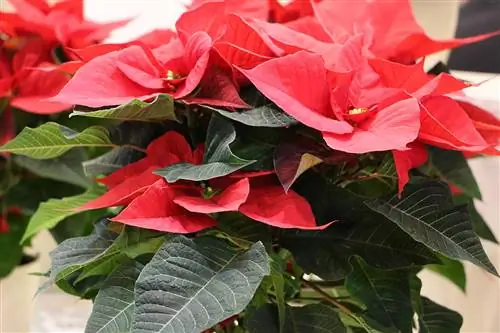
You can do something about it:
- cut off all dried plant parts
- Place the plant and pot briefly in a bucket of water
- soak well with water
- Water should be low in limescale and lukewarm
- then take the pot out again and let it drain well
- for high humidity, spray leaves additionally with water
- Water requirement increased, especially during flowering
- Check soil moisture every three to four days
Tip:
Parts of plants that have already been damaged by drought usually do not recover and fall off despite all conservation measures.
Due to constant wetness
The most common poinsettia is watered too much or too frequently, which can cause damage to leaves, shoots and roots. Symptoms usually first appear on the lower leaves. If root rot in particular has progressed to such an extent that the trunk has become soft, the poinsettia can no longer be saved. As a rule, a lack of water is much easier to remedy than incipient root rot due to waterlogging.
- If damage is caused by wetness, unpot the plant quickly
- Clean and disinfect the pot thoroughly
- or use new pot
- Removing the plant from the old pot
- remove old substrate and rotten root parts
- equip a clean pot with a drainage layer
- then fill in fresh, loose substrate
- Insert poinsettia in the middle
- exactly as deep as before in the old pot
- fill with soil, press soil down
- Do not water two days after repotting, later water moderately
Tip:
If the poinsettia loses leaves a few days after purchase, it may have already been exposed to enormous stress in the store, because they are often much too damp, too cold and drafty in the store. It is therefore recommended to repot the plant in question directly into fresh substrate.
Lack of light as a cause
Euphorbia pulcherrima requires lots of natural light most of the year. If it is too dark, its leaves will curl up and fall off. Then you should put it in a more suitable place.
- choose a bright and warm location
- without direct and blazing sun
- ideally in front of an east or west window
- South window only with sun protection
- In the warm months you can also go outdoors
- but then in slightly shaded places
- start light deprivation at the end of September at the earliest
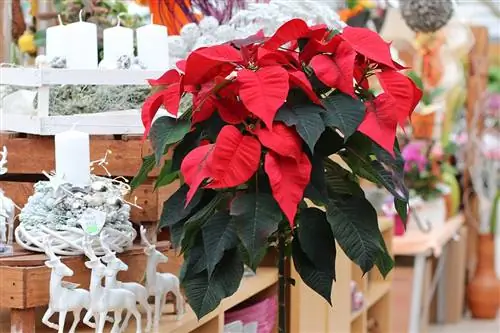
Despite everything, the poinsettia needs darkness for several weeks in autumn without artificial light sources for more than 12 hours a day in order to develop the characteristic red bracts and flowers. Because the poinsettia is a so-called short-day plant. If it is exposed to light for more than twelve hours a day in autumn, it will usually refuse to bloom. The leaves remain green and the bracts do not turn red.
Preventive measures
Prevention, as is often the case, is the best plant protection, including with poinsettias (Euphorbia pulcherrima). If you pay attention to a few things, you can prevent the substrate from drying out completely or from becoming waterlogged.
- water moderately depending on location and temperature
- preferably with a weekly immersion bath
- until no more air bubbles rise
- or fill the coaster with room temperature water
- Put the plant inside for 15 minutes every two to three days
- then remove excess water in the coaster
- Let the substrate dry to a depth of approx. two centimeters until the next watering
- Never allow the inside of the bale to dry out completely
- pay attention to higher humidity
- Do not place the plant near the heater or in direct sunlight
Things worth considering when purchasing
In order not to bring home already damaged plants, you should pay attention to he althy plants when purchasing.
- should have lots of green leaves
- the darker, the more robust
- no yellowed, dried or curled leaves
- Earth neither dry nor wet
- Blossoms ideally not yet open
- Avoid specimens with soft shoots
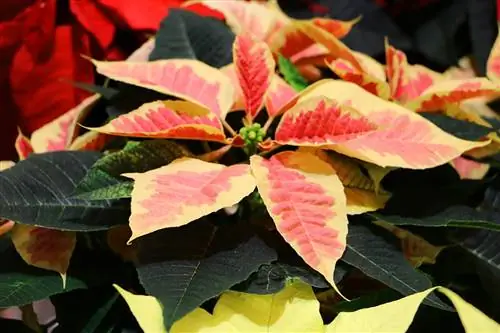
Tip:
Plants that are sold as so-called mini poinsettias should be left alone because they are usually annual cuttings. They are trimmed for early flowering and are particularly sensitive.

